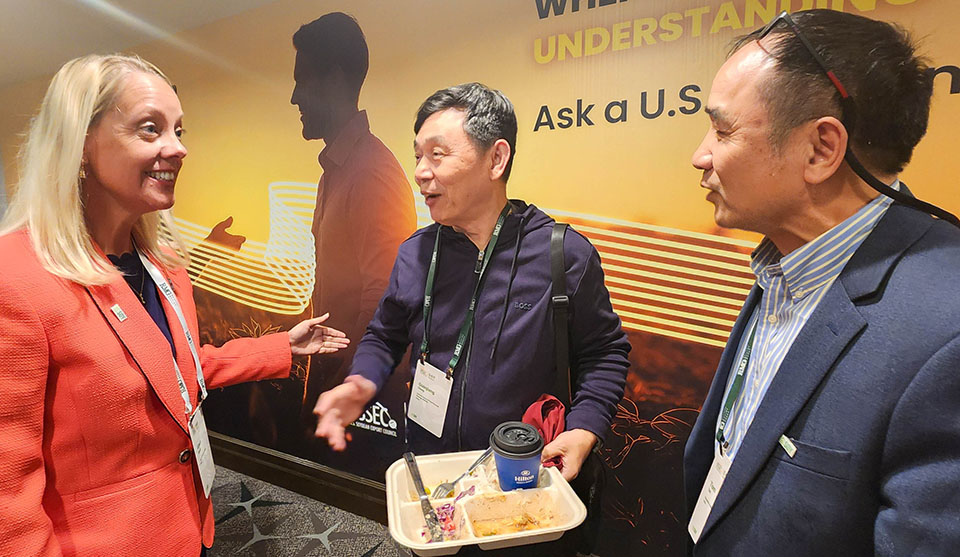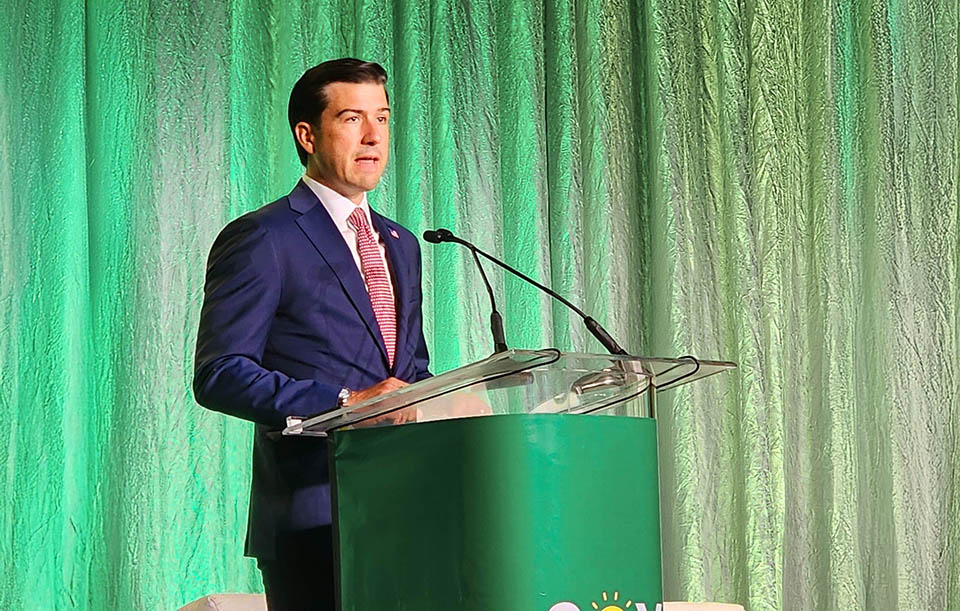
Iowa Soybean Association Director Aimee Bissell (left) of Bedford visits with (center) Guuqiang Cheng of the National School of Food Security Strategy – China and Tom Lin Tan, Executive President, Hopeful Grain and Oil Group Co., during this week’s USSEC Soy Connext summit in Washington, D.C. The conference began Wednesday evening and continues through midday Friday. (Photo: Iowa Soybean Association / Aaron Putze)
As U.S. soybean crop matures, anxiety grows over lagging Chinese demand
August 21, 2025 | Aaron Putze, APR
While U.S. global soybean sales remain strong, a lack of buying interest from the world’s top market for soy continues to weigh on the minds of U.S. farmers.
China’s absence from booking new crop U.S. soybean purchases was frequently mentioned by attendees of U.S. Soybean Export Council’s Soy Connext Conference taking place this week in Washington, D.C.
“It’s difficult to find the silver lining when our largest market historically for U.S. soybeans is sitting on the sidelines,” said Iowa Soybean Association (ISA) President Brent Swart. “Each day that goes by with no news is one day closer to when the clock runs out and our window to make sales closes on another marketing year.”
Swart is one of eight Iowa farmers and more than 700 attendees participating in the three-day meeting of global producers and users of soybeans. More than 59 countries are represented, including China.
“There’s positive news if you’re a buyer of soybeans, but not so much if you’re the producer,” he added.
While U.S. soy enjoys strong sales to many countries, including the Philippines, Egypt, Pakistan and Bangladesh, sluggish interest from China is suppressing prices in the U.S. as farmers prepare to harvest another large soybean crop.
Out of alignment
“We’re about 20% out of alignment with where prices should be, and China has a lot to do with that,” says Kentucky farmer and American Soybean Association President Caleb Ragland.
His comments during today’s general session echoed sentiments included in a letter signed by Ragland on behalf of ASA and sent to President Donald Trump on Tuesday.
U.S. soybeans currently face a duty 20% higher than soybeans from South America due to Chinese retaliatory tariffs, Ragland wrote. Due to continued trade tensions, China has contracted with Brazil to meet future months’ needs to avoid purchasing any U.S. soybeans.
“That puts our farmers at an untimely competitive disadvantage, and the further into the autumn we get without reaching an agreement with China on soybeans, the worse the impacts will be on U.S. soybean farmers.”
As of midday today (Thursday), November soybeans were trading at $10.48 ¼ per bushel on the Chicago Board of Trade while cash prices in Iowa hovered around $9.80-$9.90. Both prices are far below the current cost of production for U.S. farmers as input prices remain stubbornly high.
With just 4-6 weeks remaining before another U.S. soybean harvest begins in earnest, pressure is mounting for remedies to the trade impasse.
“U.S. soybean farmers cannot survive a prolonged trade dispute with our largest customer,” Ragland says. “We need your help, President Trump.”
Luke Lindberg, USDA Under Secretary for Trade and Foreign Agricultural Affairs, says the administration is actively working to get a better deal for U.S. farmers.

Luke Lindberg, Under Secretary for Trade and Foreign Agricultural Affairs, U.S. Department of Agriculture
Fresh off a visit with Iowa ag leaders during last week’s Iowa State Fair, the newly confirmed under-secretary took the Soy Connext stage seeking to reassure farmers that their interests remain a top priority for the administration.
“We’re actively working to get a better deal for U.S. farmers and are in constant communications with our trade ambassadors,” he says. “U.S. ag is unequivocally at the table in every negotiation and the trade deals currently on the table will create prosperity in rural America.”
But securing trade deals is just one step in the process, he adds.
“It’s also important we put dollars back into the pockets of U.S. farmers by holding parties accountable for the deals they make,” Lindberg says. “Agreements must stick in the short term and be successful in the long run.”
Absorbing demand
As global demand for soy increases, Brazil’s rapid expansion of acres and production is more than keeping pace.
“It’s hard to overstate how impactful Brazil’s acreage expansion has been,” says Bruno Coletti, oilseeds analyst for Cargill. “As demand continues to grow, Brazil is soaking up that demand.”
Since 2015, the South American country’s soy outputs has increased 76%, with 2024-25 production totaling 169 million tons on 47.4 million hectares. That compares to an expected U.S. production this year of 117 million tons.
Soybeans have become Brazil’s primary agricultural export commodity by volume, accounting for more than 60% of the soybeans grown domestically.
“In terms of exports, commitments for U.S. new crop purchases are pretty low,” says Coletti. “Sales are picking up a little, but we are sitting at about 10% of expected exports for next year sold.
“This is the second lowest since 2019,” he adds. “It’s a point of concern. There’s time for exports to pick up, but they need to.”
Historically, China accounted for 60% of U.S. soybean exports, with the primary sales window September through January. Last year, China’s share of U.S. soy exports declined to 45%. Current new crop U.S. sales to China are literally zero.
“Will that change? Unfortunately, I don’t have the answer,” Coletti says. “As of right now, all we know is that tariffs are in place and sales to China are zero. Their lack of buying is a major source of concern.”
As each day passes with no announced sales, anxiety within the U.S. soy value chain increases.
“We have time, but the clock is ticking,” he says. “Each week we don’t see progress is another week of uncertainty.”
Historically, 60% of U.S. sales to China are completed by December and 75% by January.
“If there is to be a change in tariffs, it’s important to keep in mind seasonality,” Coletti says. “If the market doesn’t see this picture changing any time soon, especially into October, if there is a deal past that point, the possibility of flows and basis changing around the world is very slim.
U.S. advantages
While Brazil has usurped America as the world’s largest soybean producer, U.S. retains a competitive advantage in logistics and quality.
Testing conducted by AgCom finds up to 5% of Brazilian soybeans are damaged compared to literally zero U.S.
Oil derived from damaged soybeans is darker, requiring further processing.
“So many buyers hesitate or complain about the oil quality from damaged beans,” says AgCom founder German Bosch. “Oil is easier to treat with U.S. soy and therefore, more economical.”
U.S. soy is also recognized for its high amino acid content, which enhances digestibility and feed efficiency for livestock and poultry. At the same time, more buyers are requesting testing for potential contaminants, including mycotoxins and pesticide residues. Again, U.S. stacks up well against the competition.
Elevating awareness of U.S. soy’s competitive advantages is the path forward for the industry, says ISA at-large director and Soy Connext participant Aimee Bissell.
The Bedford farmer traveled to Washington, D.C. to visit with international buyers and make the case for the long-term advantages of buying and using U.S. soy.
“We have a great opportunity to spread the uniqueness of our commodity, to differentiate ourselves from others,” says Bissell. “Their (Brazilian) price might be lower, but I’m not sure the return on the investment is there, which makes our soybeans a better value.
“We need to share that information with buyers, which is why we are here at Soy Connext.”
Written by Aaron Putze.
Back